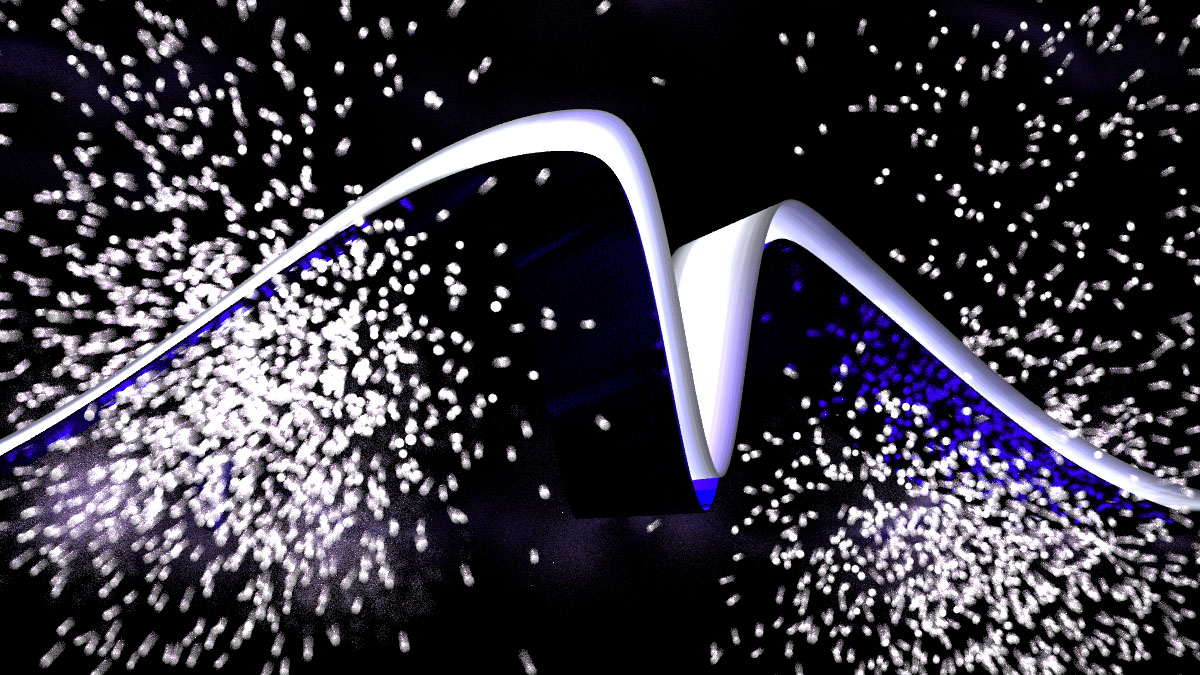 Artistic image of a soliton
Artistic image of a solitonBack in 1834, sitting on the canal bank, John Scott Russell watched the behavior of the water. It was at this moment that the concept of a “solitary wave” appeared, which later became known as the soliton. This term refers to a solitary wave that propagates in a nonlinear medium. The behavior of solitons is similar to the behavior of particles, because when interacting with each other, they do not collapse, but continue to move. Solitons have become the basis for the study of many different concepts and phenomena, from heart rate to tsunami waves. However, today we will consider the study, which was based on dark solitons (dark pulses). Why did the solitons go to the “dark side of power”, how to use this phenomenon and did the researchers manage to get the desired results of their practical experience? All of this will tell us the report of scientists. Go.
For a start, it is worthwhile to determine what the dark soliton is. As we have already understood, a soliton is a wave traveling in a nonlinear medium by itself. A dark soliton is formed when this intensity locally decreases in a continuous wave of a certain intensity. That is, these are gaps in the wave, no matter how rough it sounds.
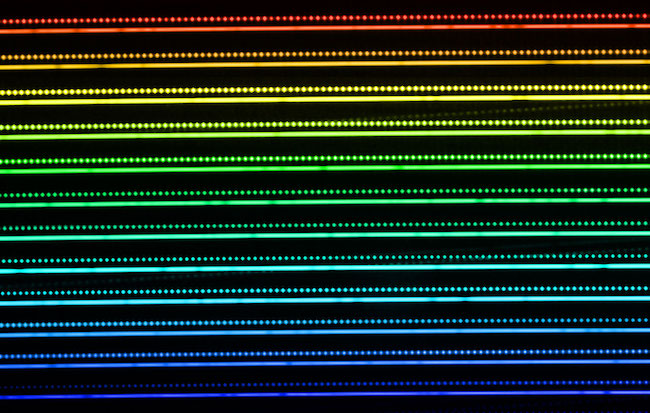 Frequency Crest ExampleThe frequency crests * of the
Frequency Crest ExampleThe frequency crests * of the microresonator use the nonlinear
Kerr effect * in the integrated optical cavity to generate a variety of phase-frequency lines. The interval between the lines can reach 100 GHz, which makes the system an excellent multi-wavelength light source for fiber-optic devices and systems.
The dispersion * of the microcavity affects the physical dynamics itself. A recent study of the states of the frequency comb has demonstrated the formation of dark pulses in a microcavity with normal dispersion.
Frequency crests * - a laser light source whose spectrum consists of a series of discrete equidistant frequency lines.
The Kerr effect * - in electro-optics, this phenomenon of changes in the value of the refraction of an optical material is proportional to the square of the intensity of the applied electric field.
Wave dispersion * - the difference in the phase velocities of the waves depending on their frequency.
Such “dark-impulse” ridges have become very popular among researchers due to their possible use in
coherent communications * due to the very high
efficiency * .
Coherent optical communication * is a type of optical communication in which information is transmitted using a light signal due to its phase modulation.
Efficiency * (EFFICIENCY) - an indicator of system efficiency, determined by the ratio of the useful energy used to the total amount of energy received by the system.
This study describes the first experiment with coherent data transmission using 64-
quadrature amplitude modulation * encoded on the frequency lines of a dark pulse ridge.
The quadrature amplitude modulation * is the sum of two carrier oscillations of the same frequency, but shifted in phase relative to each other by 90 °.
The impressive efficiency of the comb made it possible to achieve the
signal-to-noise ratio * in the amount of 33 dB. At the same time, the
pump power level of the
laser * remained comparable to the power of modern hybrid silicon lasers.
Signal to Noise Ratio * (SNR) is the ratio of the power of the useful signal to the noise power. The larger the signal-to-noise ratio, the less noise the system has.
Laser pumping * - the process of transferring the energy of an external source into the laser working medium.
Hybrid silicon laser * - semiconductor laser (laser, the working substance of which is a semiconductor), made of silicon and semiconductor materials of the III-V groups.
The basis of researchMany researchers and people associated with data transmission technologies would not have refused to replace the large number of lasers used in optical systems based on WDM (Spectral Channel Compression) with an optical frequency crest.
Until recently, practical experiments were aimed at studying lasers based on
mode synchronization * and electro-optical frequency crests made using a cascade of phase and intensity modulators. The electro-optical comb generator is able to use a single laser as a primary source, and then replicate its properties into several channels. To increase the bandwidth even more, it is necessary to use non-linear amplification, which will increase the number of WDM channels.
Mode synchronization * - the method of phase coupling of various longitudinal modes in a laser.
Modes * are normal waves that exist in a dynamic system with constant parameters in the absence of absorption and dissipation of energy.
It is also worth noting that optical frequency crests have a stable
frequency interval * , which is accompanied by an improvement in transmission performance to the maximum possible level when using unsynchronized lasers.
This study demonstrates a multichannel algorithm for compensating for the non-linear interaction of signals, as well as the possibility of reducing inter-channel gaps (we use this word as the most appropriate term for the term
Guard band * ).
Frequency interval * - the value displayed as a logarithm of the ratio of two or more frequencies, or bandwidth.
Guard band * - unused part of the spectrum between the waves.
Another interesting prospect of using the frequency ridge in WDM systems is the ability to reduce the resource requirements on the signal receiving side by implementing mutual compensation and tracking for several data channels. This technique uses as a basis the phase coherence of the frequency ridge, which makes it inapplicable in arrays of multiwave lasers.
To implement the introduction of WDM transmitters, while minimizing the number of discrete components, we had to use a
photonic integrated circuit * .
Photonic integrated circuit * is a multi-component device made on a flat substrate, necessary for processing optical signals.
The first practical experiments included the use of silicon-organic hybrid modulators, quantum-pulsed lasers with mode locking, and laser diodes with
gain control * .
Gain-switching * (Gain-switching) is a technique in optics that allows you to create a laser that produces light pulses of incredibly short duration (literally in femtoseconds).
For research, a CMOS-compatible system was created. Frequency ridge microresonators were based on silicon nitride (
Si 3 N 4 ). These microresonators use the Kerr effect in microcavities to separate light from a continuous-wave laser along evenly distributed lines in a wide band.
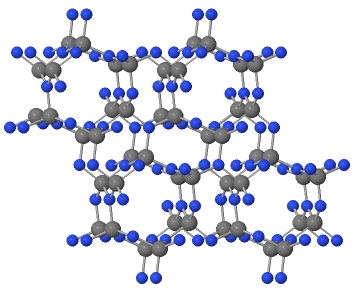 Molecular structure of silicon nitride (Si 3 N 4 )
Molecular structure of silicon nitride (Si 3 N 4 )The first data transfer was demonstrated by 64-QAM (quadratic
amplitude shift keying * ), which displayed digital data with or without a carrier wave.
Amplitude keying * is a change in the signal at which the amplitude of the carrier oscillation changes abruptly (as an example, in telegraphy, Morse code).
Soon, researchers were able to find out that the performance of microresonator ridges is very high and meets the requirements of modern coherent communication systems, in particular, in terms of frequency stability, signal-to-noise ratio and line width. For this reason, it was decided to conduct experiments, including long-distance communication systems and the expansion of modulation formats.
Detection of
dissipative solitons in microresonators and stabilization schemes associated with them
* Kerr opened the possibility to more effectively control the width of the band and the number of ridge lines.
Dissipative soliton * is a structurally stable solitary wave propagating in a nonlinear medium, localized in time or space with the participation of the balance of the influx and escape of energy in a physical system.
One experiment showed excellent results using two silicon nitride microresonators covering the light-guiding bond between the C and L bands.
Microresonator frequency crests are very complex systems that allow several modes of operation with low noise levels. However, coherent communication systems mainly focus on crests operating in bright soliton and coherent modulation modes. In this study, a mode-locking state was identified when the cavities exhibited normal dispersion. This state of the ridge corresponds to the circulating dark impulses in the cavity. And this can be very interesting for coherent data transfer in WDM systems.
Measurements of the crests of dark pulses showed a 30% higher efficiency than the crests of bright solitons. In practice, such a large difference could be used to reduce power requirements or to increase SNR.
This study, according to scientists, is the first demonstration of a coherent WDM data transmission system based on crests of dark pulses. In this case, an external power source was used (800
mW * ). Data was transmitted over a distance of 80 km over 20 channels, each of which contained data encoded with 20-
gigabyte * 64-QAM, which showed an average transfer rate of 4.4 TB / s.
mW * - 1 milliwatt = 10 -3 watts.
Bot * is a unit of measurement of symbolic speed (the number of signal states in a line per unit of time), the number of changes in the information parameter of a carrier periodic signal per second.
Research resultsFrequency comb and microresonatorsAs we already learned earlier, a silicon nitride microresonator was used to generate a frequency ridge. The radius of the resonator was 100 μm, which led to the formation of a
free spectral range * of 230 GHz.
Free spectral range * - the interval in frequency or wavelength between two successive reflections or transmitted optical maxima of the intensity or minima of the interferometer or diffractive optical element.
An annular waveguide with a width of 2 μm and a thickness of 600 nm was accompanied by a normal dispersion in the C band. The figure of
merit * was 1.6 million.
Quality factor * - or Q-factor (from ang. Quality factor ) is a parameter of the resonance width, which indicates how many times the energy supply inside the system is greater than its loss during the period of phase change by one radian.
During the experiments, a tunable laser with an external resonator with a laser radiation width of less than 10 kHz was used. Before reaching the microcavity, laser radiation is amplified and filtered to achieve a continuous pumping rate of 25.6
dBm * .
dBm * - decibel milliwatts - the ratio of the power in decibels to the measured power in milliwatts. Used in fiber optic technology to denote absolute power, as it can display both large and extremely small numbers in short form. 0 dBm = 1 mW.
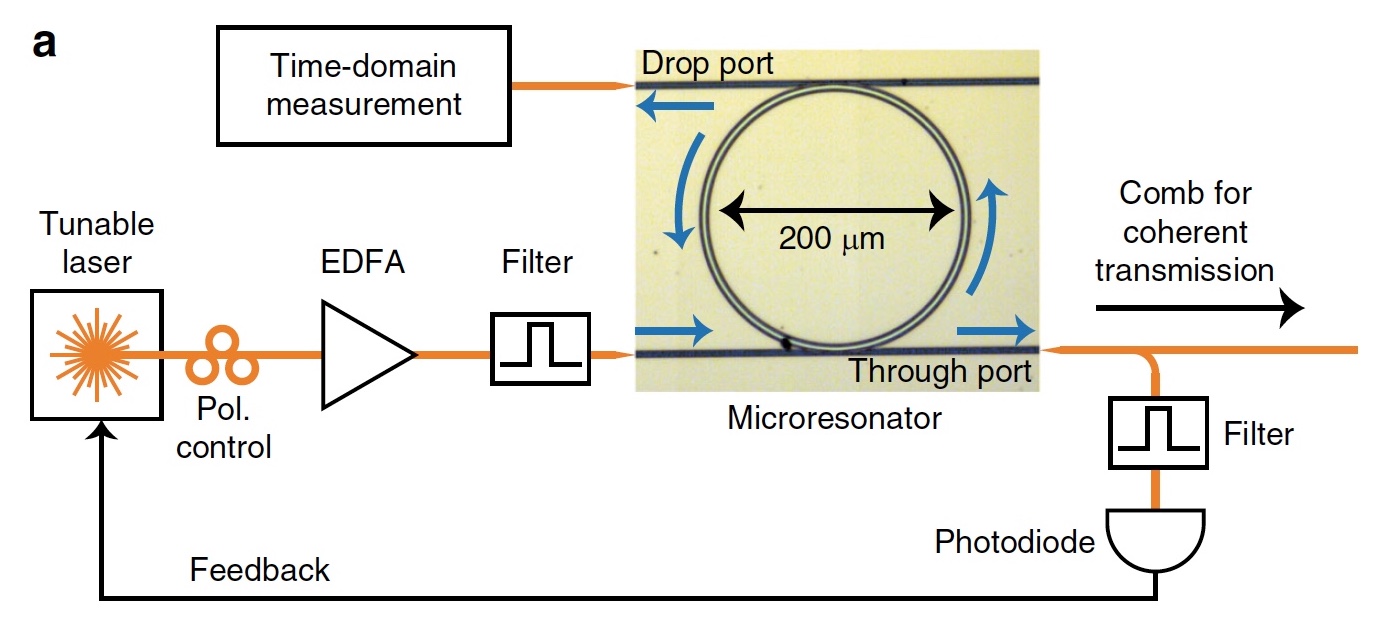 Image number 1a
Image number 1aFigure
1a shows the configuration of the crest generation process. With a high pump power, the loss on the side of the fiber-optic link was approximately 5 dB / face. The microresonator is equipped with both a throughput port and a resulting port, the latter is used to evaluate the waveform inside the resonance cavity. Due to the strong coupling between the resonator and the throughput port, the ridge obtained at the throughput port is used for communication experiments.
The formation of the ridge is carried out by converting the wavelength of the pump laser to resonance. In order to monitor the comb in the active state, a photodiode was placed on the newly formed line (about 1536 nm) immediately after the band-pass filter. (This is shown in diagram 1a).
A photodiode operating as a sort of indicator of laser wavelength settings allows the comb to be started as soon as the laser is close to resonance. Thus the pumping of the laser will stop automatically as soon as the ridge reaches a predetermined state.
Such anchoring of the connection between the photodiode, the laser and the comb itself is not necessary to ensure the stability of the state of the latter over several hours. The point is that the cyclical feedback of the system ensures that external factors do not affect the state of the spectrum.
 Image №1b
Image №1bThe image above shows the curve of the characteristics of the dark pulses of the spectrum of the generated ridge at the throughput port. To ensure that the comb corresponds to the dark pulses circulating in the cavity, two separate measurements were made on the side of the resulting port.
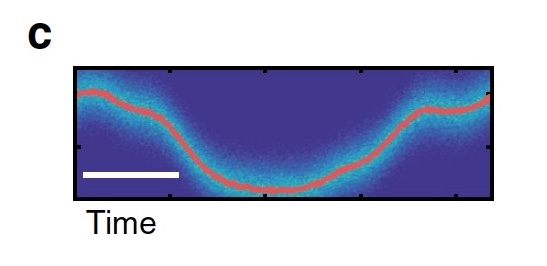 Image number 1c
Image number 1cAbove is the result of measurements made with an optical oscilloscope (500 GHz).
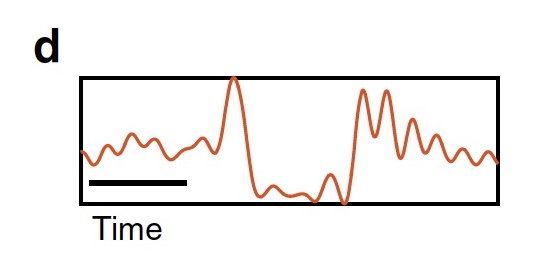 Image №1d
Image №1dAnd here we see the result of measuring the spectral phases of the ridge.
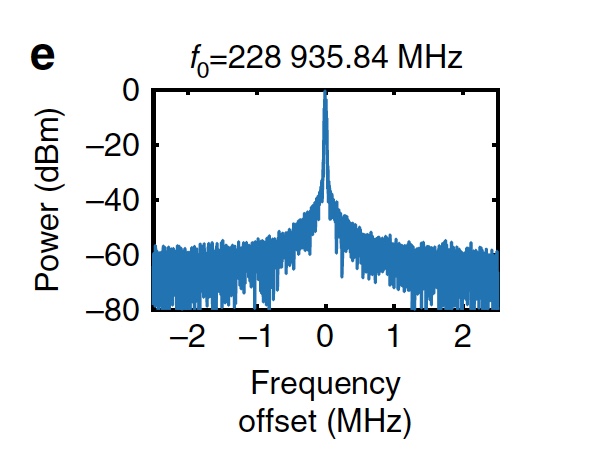 Image number 1e
Image number 1eFinally, a beat graph demonstrating a pronounced peak> 50 dB above the noise level. In this case, the Gauss function fits into the
FWHM * <30 kHz. All this indicates that mode synchronization works at a level much higher than that required for modern WDM systems.
FWHM * - full width at half amplitude level - the difference between the minimum and maximum values of the function argument, taken at the level of half of its maximum value.
Optical data modulationNow the microreson comb is ready for use in data transmission using certain modulation formats. In order to maximize the power of the ridge during the data transfer experiment, the researchers used a comb of dark pulses in the access port as a light source for transmission. The total capacity was no more than 28 mW (of which 8.6 mW belong to the newly formed crest waves). Efficiency increased by 20%.
Following our crest is a narrow-band rejection filter (200 GHz), the task of which is to suppress the central crest wave, which makes it possible to more effectively operate an optical amplifier (EDFA).
 Image number 2a
Image number 2aThe data transmission scheme over a single range over a distance of 80 km is shown in image
2a .
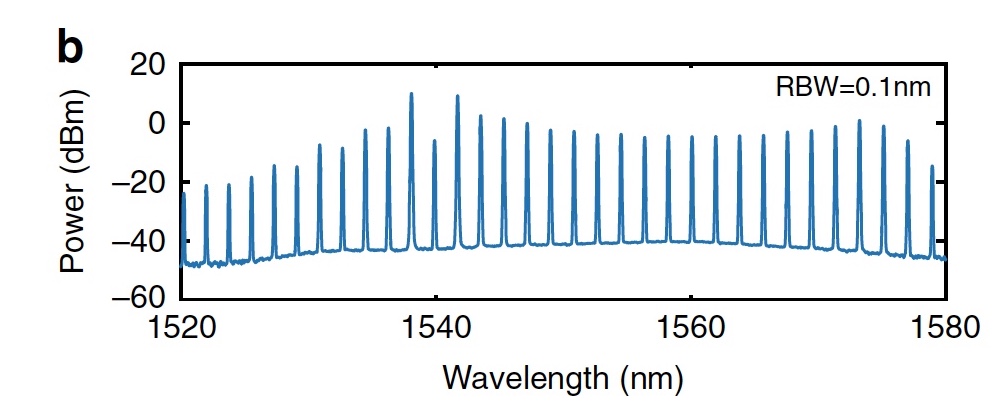 Image 2b: The spectrum of the ridge after amplification and filtering.
Image 2b: The spectrum of the ridge after amplification and filtering.Following the optical amplifier, a selective wavelength switch (WSS) is installed, through which the power of the comb is divided into two directions (odd (odd) and even (even)). This allows you to hold the required number of waves going to each modulator (10 each). In addition, the switch allows you to equalize the power of the waves of the ridge in each direction separately.
Each of the modulators is controlled by signals from arbitrary waveform generator (AWG), each of which is programmed to generate two independent random 64-QAM signals using a
square wave * , each pulse of which carries 6 bits per symbol with a speed of 20 gigabot.
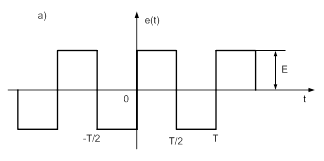
Meander * - a rectangular periodic signal.
The random frequency consists of 216 characters, and the
resampling * is 3, since the AWG can only work at 60 GS / s.
Oversampling * - changing the sampling rate of a discrete digital signal.
In order to level inaccuracies in digital-to-analog converters (DAC) and modulators, digital pre-compensation was applied to the signal in the AWG.
Next, the multiplexing stage * with division and delay is activated, where a branch ≥1 m long corresponds to ≥100 data symbols. Using both multiplexing methods has doubled the performance of the system.
The last stage - both branches (both directions of signals) are recombined and compacted, and then sent directly to the communication channel.
 Image number 2c
Image number 2cThis image (
2c ) demonstrates how the second compaction stage converts the power difference of the two directions into a slightly varying noise level.
Data transfer resultsFollowing the 80-kilometer standard single-mode fiber optic cable is a multipolar single-channel coherent receiver. A tunable laser with an external resonator, whose line width is less than 100 kHz, acts as a local oscillator. This allows you to get one data stream at a time using a 23 GHz oscilloscope operating at 50 GS / s. Next, standard offline digital data processing algorithms are connected to the process.
 Image No. 3a, which shows the data transfer scheme.
Image No. 3a, which shows the data transfer scheme.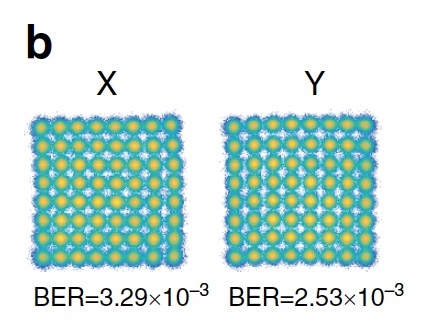 Image # 3b: constellation * 64-quadrature amplitude modulation.
Image # 3b: constellation * 64-quadrature amplitude modulation.The signal constellation * is a diagram representing different values of the complex amplitude of signals subject to manipulation on the complex plane.
In order to ensure the optimum signal power level, the data were recorded with different starting power. In the
3c image, we can see the most optimal variant when the starting signal power is 3 dBm / channel. This level is really the most suitable, since higher power leads to nonlinear distortion, and lower power reduces the performance of the entire system.
 Image number 3c
Image number 3cThe coefficient of bit errors was also calculated (the error was exaggerated, that is, the ratio of erroneous bits to the total number of transmitted). This indicator was obtained by comparing the decoded bit stream with the transmitted one. The bit error rate turned out to be more than acceptable for all ridge lines, given that the transmission was carried out at 80 km. In addition, the calculation of the bit
error rate (
BER ) makes it possible to effectively use
direct error correction * with a margin of 9.1%. After this procedure, the bit error rate is below 10
-15 , which guarantees data transfer with a speed of about 4.4 TB / s.
Forward error correction * - a method of encoding or decoding, due to which it is possible to correct errors by advancing, that is, not only the necessary data is transmitted, but also redundant service data, which allow to restore the original content of the transmission as a result.
The final experiment was carried out without the participation of fiber optic cable, that is, a direct connection of the transmitter and receiver. This allows you to check two important points:
- check the performance of the transmitter / receiver in ideal, that is theoretical, conditions, when only additive white Gaussian noise is taken into account.
- determine losses on the side of the ridge and on the side of the transceiver system, by comparing the results with similar measurements made using an autonomous laser.
The measurements were carried out by evaluating the BER obtained with respect to different levels of SNR (signal-to-noise ratio).
 Image №3d
Image №3dAs can be seen from the graph above, for the selected BER limit in the size of 7x10
-3 ridge lines require a slightly higher OSNR (from 0 to 0.5 dB) compared to the free-lasing laser system.
The ridge lines demonstrated that an increase in OSNR of 3 dB, taking into account theoretical predictions, is necessary to achieve the desired BER value.
These experiments have shown that microresonators of frequency crests do not impair transmission performance, which makes them excellent sources of light for a coherent communication system of high order.
additional informationAccording to scientists, their research and practical experience are extremely important in that they demonstrate the ability to use the efficiency of dark-pulse crests to achieve a signal-to-noise ratio of> 33 dB, while maintaining the internal pump power at a level of several hundred mW.
Despite the fact that the spectral efficiency was rather low (about 0.95 B / s / Hz), these indicators are not boundary for data transmission systems based on frequency resonating microresonators.
This study helped to achieve an improved signal-to-noise ratio for long-wave channels through an optimized dark-pulse ridge. The achieved level of the signal-to-noise ratio is comparable to modern systems of hybrid silicon lasers, which demonstrate an optical line width of 15 kHz, and a power level of about 100 mW.
The signal-to-noise ratios obtained during the experiments are quite large for high-order modulation, while the error level is kept at a sufficiently low level, even when the crest and other subsystems work together during the transmission of information.
From the point of view of data transmission, the weakest line in the ridge will set the minimum threshold for a possible signal-to-noise ratio for each line on the transmitter. The power level of the line can be increased by optimizing the dispersion coefficient and the coupling rate of the microresonator.
To test this theory, an optimization test was carried out, where the above parameters were changed, and all the others remained the same. The pump power of the laser remained at 100 mW, and the line spacing at 100 GHz, since this level is most suitable for WDM standards. The experiment showed that the use of a larger resonator with a smaller free spectral range can lead to the fact that the dark-pulsed crest will cover the C band, while the interval will be at 100 GHz.
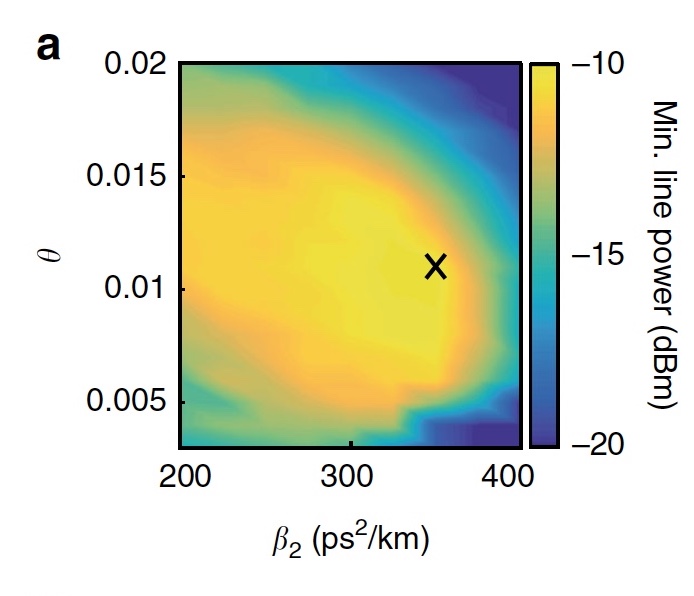 Image number 4a: demonstration of optimization results.
Image number 4a: demonstration of optimization results.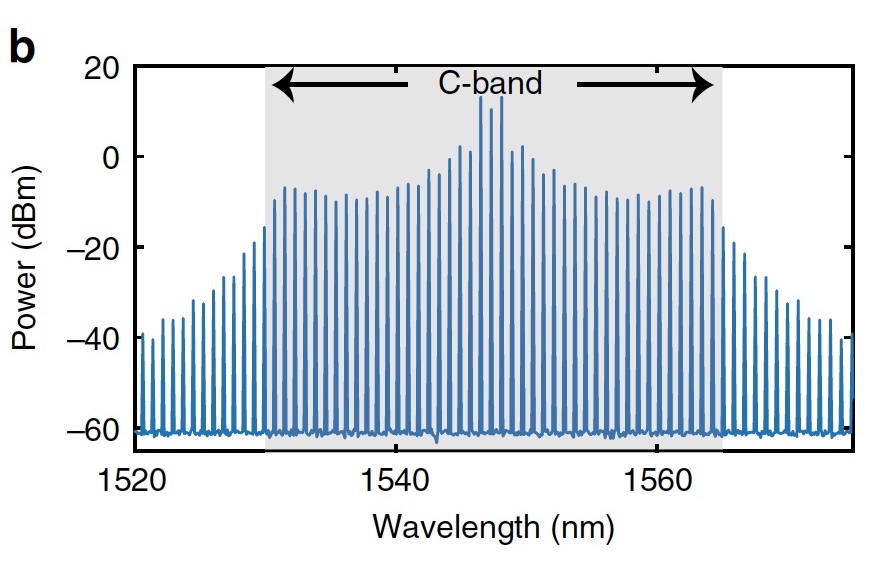 Image No. 4b: The weakest line inside the C band appears at -10 dBm.
Image No. 4b: The weakest line inside the C band appears at -10 dBm.The crest line powers range from 51 to 71 dB above the quantum noise limit.
The graph below shows the signal-to-noise ratio requirements for various modulation formats and different symbol rates.
 For more detailed acquaintance with research I recommend to familiarize with the report of scientists, accessible on the link.Epilogue
For more detailed acquaintance with research I recommend to familiarize with the report of scientists, accessible on the link.EpilogueNaturally, this study and practical experience based on its results are the first step in understanding how to apply similar phenomena and techniques in the future. Any experiment must first answer the most important question - is it worth further research or can the game not be worth the candle? In this case, dark-pulse frequency crests showed excellent results. And this means that in the future we will see quite a few scientists trying to more thoroughly understand the use of microresonators and dark pulses. Will these studies play an important role in data transfer technologies? Maybe. No one has the right to say for sure, since there is still a lot to be understood, starting from the very technique of microresonators and ending in ways to improve it. However, you should not be skeptical of all studies by default, because in any case, each of them contributes, maybe insignificant, or enormous, to our future.
Thank you for staying with us. Do you like our articles? Want to see more interesting materials? Support us by placing an order or recommending to friends,
30% discount for Habr users on a unique analogue of the entry-level servers that we invented for you: The whole truth about VPS (KVM) E5-2650 v4 (6 Cores) 10GB DDR4 240GB SSD 1Gbps from $ 20 or how to share the server? (Options are available with RAID1 and RAID10, up to 24 cores and up to 40GB DDR4).
Dell R730xd 2 times cheaper? Only we have
2 x Intel Dodeca-Core Xeon E5-2650v4 128GB DDR4 6x480GB SSD 1Gbps 100 TV from $ 249 in the Netherlands and the USA! Read about
How to build an infrastructure building. class c using servers Dell R730xd E5-2650 v4 worth 9000 euros for a penny?